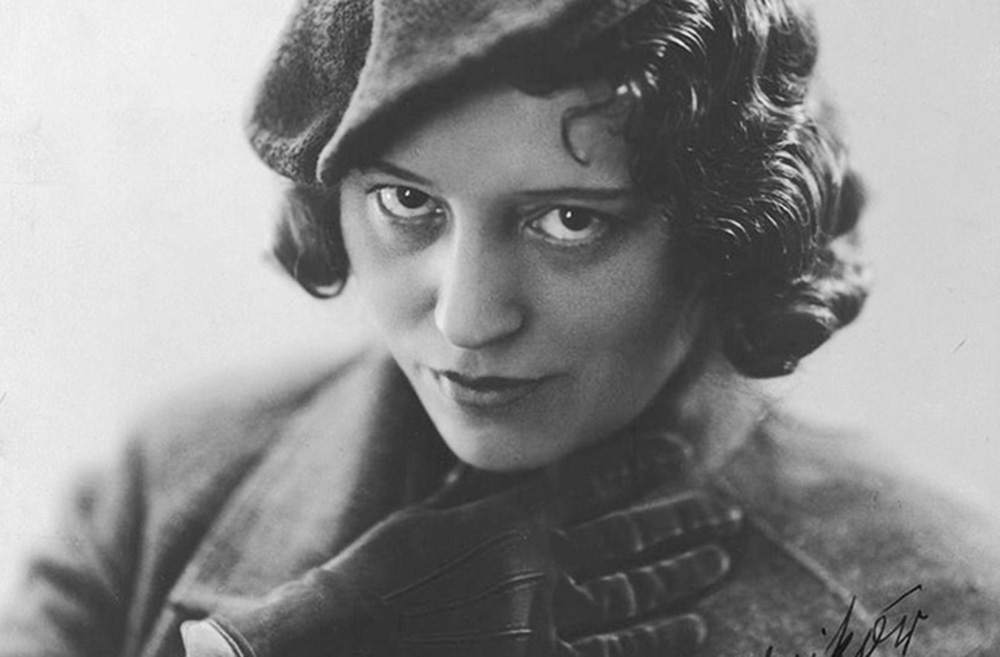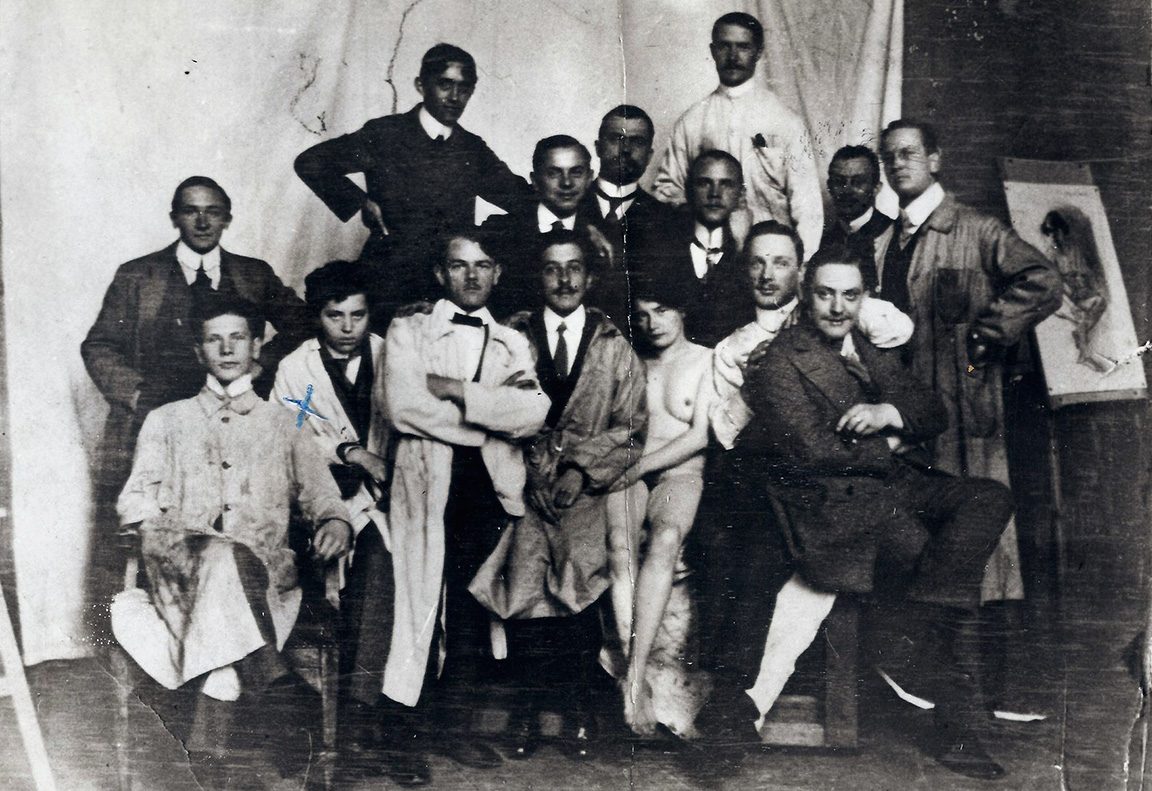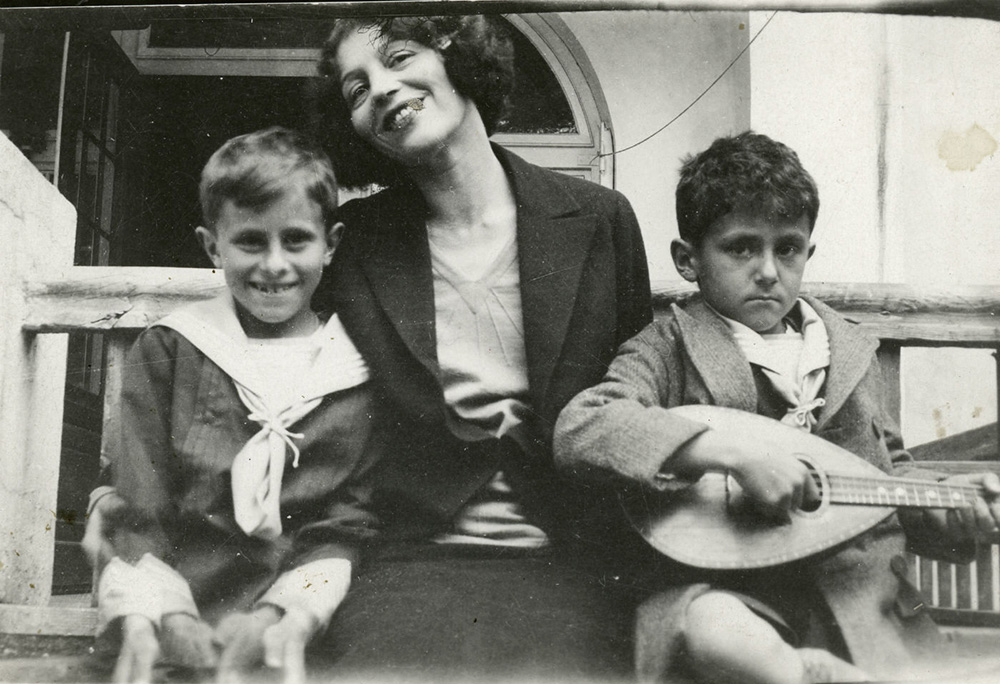Artist, Mother, Man: The Diaries of Zofia Stryjeńska
Zofia Stryjeńska, one of the most important art deco artists of the inter-war period, struggled to be the artist that she truly wanted to be. She kept a careful record of it all in her diaries, where her thoughts and feelings revealed family strife, money problems, and what happened when she pretended to be a man called Tadeusz Grzymała.
Despite living about a century ago, she would become a woman whose problems feel very modern. She would have to balance work and children, struggle financially, and she got divorced twice – common issues in the 21st century. Most of all though, her diaries reveal that although she had great talent, she was also the queen of exaggeration, hysteria, jealousy and fury.
Women’s struggle throughout history
 Zofia Stryjeńska, photo: National Digital Archive NAC
Zofia Stryjeńska, photo: National Digital Archive NAC
Remember how Gwyneth Paltrow in Shakespeare in Love disguised herself as a man to be able to play in English Renaissance theatre? There are more heroines like this but from true history, most notably because they wanted to fight in wars, just like Joan of Arc did, or Malinda Blalock and Sarah Edmonds in the American Civil War. Charlotte Brontë, Mary Ann Evans and even J.K. Rowling chose to hide their gender when publishing novels.
Poland is no exception to this phenomenon. In 1907, the poet Maria Komornicka burnt her dresses and took on the name Piotr Odmieniec Włast to reveal what she felt was her true gender and trespass the limits of womanhood. First-wave feminists such as Maria Dulębianka chose masculine attire as a sign of their independence and engagement in social issues.
In the 19th century, one of the pervasive problems inspiring dissatisfaction all over Europe was reduced access to higher education. The aforementioned Dulębianka studied art in Paris and Vienna, since women were not allowed to enroll in the Fine Arts Academy in Kraków. It lasted into the 20th century, as three decades later, the so-called ‘princess of Polish painting’ Zofia Stryjeńska would disguise herself as one Tadeusz Grzymała Lubański to be able to study art in Munich.
The first masquerade of a great artist
 Munich Art Academy, photo: David Kostner/wikimedia.org
Munich Art Academy, photo: David Kostner/wikimedia.org
Zofia Lubańska was born in 1891 in Kraków. Interested in art from a very young age, she had a great eye for detail. Much of the colourful, Slavic folk figures, customs and clothing she would later famously portray were inspired by what she saw whenever her father took her to visit the city’s vibrant markets. In his shop, she started her ‘career’ by painting caricatures of clients.
It wasn’t long before she became certain of what she wanted to do in life. But there were barriers. In 1911, she wrote something rather peculiar in her diary about her four siblings:
Stefuś graduated from music school and started earning money playing in the orchestra and in church choirs; Maryla and Janka remained at school and I shaved my head bald and in Tadzio’s clothes and with his documents, I enrolled to the Fine Arts Academy in Munich, since this was the school considered the best and most challenging of all. My masquerade was inevitable since women were not allowed at the Munich academy nor in other universities.
That wasn’t entirely true: women could actually study in Warsaw at this point, and while in Kraków, Zofia herself studied at Maria Niedzielska’s private fine arts school. But with this gesture of changing her identity, she established herself as a revolutionary, ready for anything to dedicate herself to art.
In the archives of the Munich academy, only slim information can be found: Tadeusz Grzymała from Kraków passed the exams and was accepted along with 40 other male students. Zofia ended up spending an entire year in Munich in disguise before gossip began to spread: some of her colleagues thought she might be a hermaphrodite and wanted to take her clothes off.
Especially the French, who are good at sensing women.
 Munich Art Academy, 1911-1912. Zofia Lubańska (as Tadeusz Grzymała) second from the left, photo: Stryjenski family archives
Munich Art Academy, 1911-1912. Zofia Lubańska (as Tadeusz Grzymała) second from the left, photo: Stryjenski family archives
Her main fear though was that she would be accused of fraud: after all, she had used her brother’s documents. After a while, the pressure got to her and she escaped. Before she returned to Kraków, she went to a chapel, lied down on the floor and prayed, as described in her diary:
God! Take everything, everything from me. My well-being, my satiety, peace, human friendship, family life, even love! […] but please instead give me […] fame!
These words – which she later crossed out – can be seen as a prophecy and as a curse…
Before she left Munich though, she was affected by the city’s artistic atmosphere. There she saw paintings by Rembrandt, Velasquez and Brouwer. It was the place where Expressionism was born and Wassily Kandinsky lived at the time. Most of all, she was fascinated by the Russian dancer and painter Alexander Sakharoff. A few years later, she would create a series of paintings entitled Romans z Życia Nieznanego Artysty (Romance of the Life of an Unknown Artist) dedicated to him. Ironically, part of Sakharoff’s reputation in Munich was that he was known for strolling around town in women’s clothes.
Slavic folklore reinvented
 A lithograph by Zofia Stryjeńska from her series Slavic Idols (Bożki Słowiańskie), 1917, photo: Andrzej Chęć / courtesy of the National Museum in Kraków
A lithograph by Zofia Stryjeńska from her series Slavic Idols (Bożki Słowiańskie), 1917, photo: Andrzej Chęć / courtesy of the National Museum in Kraków
Back in Kraków, and back as Zofia Lubańska, she launched her career. Her timing was perfect: her favourite subjects of Polish folklore and Slavic customs were much desired by a joyous public whose country had just regained its independence and identity after 123 years of occupation.
Her lithographs entitled Bożki Słowiańskie (Slavic Idols) – essentially, a sort of Polish Olympus series – were highly praised, with critics comparing them to Stanisław Wyspiański’s works. The portrait series Młoda Wieś Polska (Young Polish countryside) also brought Wyspiański to mind in the way in which it celebrated childhood, youth and nature.
Embeded gallery style
display gallery as slider
Her works went into mass reproduction. They were reproduced in albums and on postcards, even chocolates were decorated with her portrayals of Slavic idols. Their colourful vitality, geometric forms and motifs from Slavic folklore and Polish history created a unique combination, making Stryjeńska one of the most celebrated artists of the inter-war period. Unfortunately, despite all this, she was paid very little for all this unlicensed commercialisation of her work.
Sacrificing family at the altar of art
 Karol Stryjeński, 1932, photo: www.audiovis.nac.gov.pl (NAC)
Karol Stryjeński, 1932, photo: www.audiovis.nac.gov.pl (NAC)
She met her husband, Karol Stryjeński, at one of the many artistic workshops she attended. He was a talented designer and a very handsome man. As she wrote:
Blond hair, Apollonian shape and sky-blue reflectors.
Karol was her great love, but also a party boy, and his behaviour left Zofia feeling extremely jealous. Their relationship would seem extreme by any standard, even today. He tried to put her in an asylum twice, which was a surprisingly common way of solving marital problems at the time. She in return beat up his lover and then chased him down with a pistol. During a trip to Paris. she destroyed her own paintings in front of him, afraid he only loved her as an artist, not as a woman.
They had three children together: the first was a girl, much to the disappointment of Zofia, who was determined to give her husband a son. She wrote venomously about it in her diary:
I am angry. I jeer at good wishes. I feed the baby with aversion.
Karol Stryjeński with children, Podhale, 1920s, photo: Stryjeński family archivesShe got her wish two-fold and had twin boys afterward. But girl or boy, none of the children could help her marriage. After she and Karol divorced, she lost her parental rights and the kids went to live with their father’s family.
I burned family life at the altar of art.
Right before World War II, they came to live with her, but she found them a distraction. She drew a line on the floor which the kids weren’t supposed to cross: she needed peace and quiet to work. When she painted – as she wrote in her diaries – the ‘fury of art’ overwhelmed her. She always strived for fame.
And she did achieve fame for a while – though not as great as her contemporary Tamara de Lempicka – but she never achieved richness: she wasn’t too rational when it came to spending money, but neither did she earn much selling paintings, even at the peak of her career. Many of her diary entries describe financial struggles, something she had to face pretty much all her life, whether it was when she lived in Poland, France or Belgium.
When she finally settled in Geneva, she lived a lonely life, ashamed of being unable to speak French well. She was diagnosed with schizophrenia and died in 1976.
Stryjeńska’s afterlife
 Zofia Stryjeńska with her sons, 1931, photo: Stryjenski family archives
Zofia Stryjeńska with her sons, 1931, photo: Stryjenski family archives
We don’t know much about Stryjeńska’s later years, since she stopped keeping a diary in 1950. Those early entries remain the main source of our knowledge about her life. The critical book about her diaries was published in 2016: Chleb Prawie że Powszedni: Kronika Jednego Życia (Almost Daily Bread: A Chronicle of One Life), edited by Magdalena Budzińska and Angelika Kuźniak. The award-winning reporter Kuźniak also wrote the 2015 Stryjeńska biography Stryjeńska: Diabli Nadali (Stryjeńska: Devil’s Gift). Both these books have contributed in the past few years to the forgotten painter’s revival, which began in 2008 with a major retrospective in the National Museum in her native Kraków.
Over the following years, her manuscripts were exhibited in the Jagiellonian Library in Kraków, while an exhibition was organised in Tarnów displaying her works alongside those of contemporary illustrator Agata ‘Endo’ Nowicka. And of course, she’s gotten a new life on social media, where people often share her pictures and quote her characteristic style.
As Kuźniak says, Stryjeńska was for her the perfect biography heroine:
Zocha lives. And people started talking with Stryjeńska’s words.
All those contradictions and contrasts – a pioneer female student who masks her entire identity, a mother who rejects her daughter while accepting sons, a famous painter who can’t earn a penny, a passionate lover who cherishes art more than anything, and a modern woman who looks for inspiration in the furthest past – make it difficult to put Stryjeńska in a box and make ‘an icon’ of anything out of her.
And yet, her art as well as her life can’t help but resonate with contemporary audiences. While her art enlivens our hearts and imagination, her imperfections and problems speak to our everyday worries.
Author: Natalia Mętrak-Ruda, April 2018
[{"nid":"5688","uuid":"6aa9e079-0240-4dcb-9929-0d1cf55e03a5","type":"article","langcode":"en","field_event_date":"","title":"Challenges for Polish Prose in the Nineties","field_introduction":"Content: Depict the world, oneself and the form | The Mimetic Challenge: seeking the truth, destroying and creating myths | Seeking the Truth about the World | Destruction of the Heroic Emigrant Myth | Destruction of the Polish Patriot Myth | Destruction of the Flawless Democracy Myth | Creation of Myths | Biographical challenge | Challenges of genre | Summary\r\n","field_summary":"Content: Depict the world, oneself and the form | The Mimetic Challenge: seeking the truth, destroying and creating myths | Seeking the Truth about the World | Destruction of the Heroic Emigrant Myth | Destruction of the Polish Patriot Myth | Destruction of the Flawless Democracy Myth | Creation of Myths | Biographical challenge | Challenges of genre | Summary","topics_data":"a:2:{i:0;a:3:{s:3:\u0022tid\u0022;s:5:\u002259609\u0022;s:4:\u0022name\u0022;s:26:\u0022#language \u0026amp; literature\u0022;s:4:\u0022path\u0022;a:2:{s:5:\u0022alias\u0022;s:27:\u0022\/topics\/language-literature\u0022;s:8:\u0022langcode\u0022;s:2:\u0022en\u0022;}}i:1;a:3:{s:3:\u0022tid\u0022;s:5:\u002259644\u0022;s:4:\u0022name\u0022;s:8:\u0022#culture\u0022;s:4:\u0022path\u0022;a:2:{s:5:\u0022alias\u0022;s:14:\u0022\/topic\/culture\u0022;s:8:\u0022langcode\u0022;s:2:\u0022en\u0022;}}}","field_cover_display":"default","image_title":"","image_alt":"","image_360_auto":"\/sites\/default\/files\/styles\/360_auto\/public\/2018-04\/jozef_mroszczak_forum.jpg?itok=ZsoNNVXJ","image_260_auto":"\/sites\/default\/files\/styles\/260_auto_cover\/public\/2018-04\/jozef_mroszczak_forum.jpg?itok=pLlgriOu","image_560_auto":"\/sites\/default\/files\/styles\/560_auto\/public\/2018-04\/jozef_mroszczak_forum.jpg?itok=0n3ZgoL3","image_860_auto":"\/sites\/default\/files\/styles\/860_auto\/public\/2018-04\/jozef_mroszczak_forum.jpg?itok=ELffe8-z","image_1160_auto":"\/sites\/default\/files\/styles\/1160_auto\/public\/2018-04\/jozef_mroszczak_forum.jpg?itok=XazO3DM5","field_video_media":"","field_media_video_file":"","field_media_video_embed":"","field_gallery_pictures":"","field_duration":"","cover_height":"991","cover_width":"1000","cover_ratio_percent":"99.1","path":"en\/node\/5688","path_node":"\/en\/node\/5688"}]